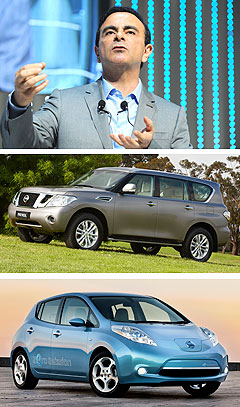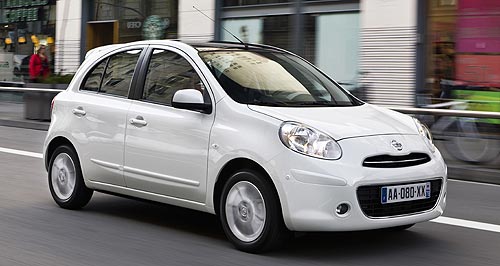Make / Model Search
News - NissanNissan weathers tsunami stormBig hit: Record sales for the Navara have helped Nissan Australia’s market share grow steadily. Higher level of foreign production protects profitable Nissan from Toyota-like slump16 May 2011 NISSAN appears to have weathered Japan’s devastating earthquake and tsunami far better than rival Toyota, reporting a better quarterly profit than anticipated despite disrupted supply and factory shutdowns. The company appears to have avoided the fate of Toyota – which last week announced a 77 per cent fall in net income – because it is less dependent on Japanese production. Only 25 per cent of Nissans are built in Japan whereas global leader Toyota manufactures 45 per cent of its vehicles at home. Nissan Motor Company reported a net income of ¥30.8 billion ($A360.2 million) in the fourth quarter (to March 31) compared with a loss of ¥11.6 billion ($A135.7 million) in the same period last year. It was the only one of Japan’s Big Three car-makers to report an improved result for the period. Honda, which was overtaken by Nissan last year, produces 26 per cent of its vehicles in Japan but reported a 38 per cent drop in profit for the quarter. For the full 2010 financial year, Nissan Motor Company reported a profit of ¥319.2 billion ($A3.73 billion) – more than seven times greater than for the previous year – after increasing sales globally by 19.1 per cent to 4,185,000 vehicles.  From top: Nissan CEO Carlos Ghosn, next-generation Nissan Patrol, Nissan Leaf. From top: Nissan CEO Carlos Ghosn, next-generation Nissan Patrol, Nissan Leaf.However, Nissan CEO Carlos Ghosn warned there is likely to be bad news ahead, saying the current fiscal quarter will be tougher for the company and its Japanese rivals as they recover from the factory disruptions and subsequent plunge in sales that followed the March 11 earthquake. Speaking at a news conference following the earnings announcement, Mr Ghosn said the carmaker’s global production levels would return to normal in October. Nissan lost production of 55,000 units in Japan in March after closing its plants until March 23, while its engine factory in Fukushima prefecture, which was damaged in the earthquake, was shut until April 17. Vehicle production has also been halted periodically from April in Mexico, the US, the UK and China due to parts supply issues. In April, Nissan’s Japanese production volume was about 40 per cent of last year’s level and the company said output this month is at about 50 per cent. Mr Ghosn said that “much less than half” of the 40 suppliers affected by the March disaster have yet to fully recover. “The March 11 earthquake in Japan significantly disrupted our operations,” said Mr Ghosn. “Although the effects of this tragedy continue to affect our operations, we are poised for a robust recovery.” Mr Ghosn said the carmaker will initially face a “significant” market share loss globally because of the earthquake, but plans to catch up in the second half of the fiscal year. Significantly, Nissan claims to have a competitive inventory advantage over its Japanese rivals in the US, where it is currently sixth in sales. In a letter to US dealers last week, Nissan said it was holding a 64-day supply of vehicles, compared with 48 days for Toyota and 36 days for Honda. Although Nissan Australia does not reveal its profit figures, company spokesman Jeffrey Fisher said the local division had turned a profit in the year to March 31 and contributed to the parent company’s impressive bottom line. Nissan Australia’s market share has grown steadily, highlighted by record sales for the Navara and strong growth for Micra and X-Trail, resulting in a move up to sixth place on the local sales chart (behind Toyota, Holden, Mazda, Ford and Hyundai). “Nissan finished its financial year with a 6.4 per cent market share and we now set our sights on at least a seven per cent share for the next 12-month period,” said Nissan Australia CEO and managing director Dan Thompson. “With more product action expected later in the year, we expect to hit our annual targets again ahead of more significant brand milestones in 2012 with the arrival of Nissan Leaf and new Patrol.” Globally, Nissan’s sales rose 16 per cent to 1.17 million in the first quarter, with significant gains in North America (up 22 per cent), China (up 26 per cent) and Australia (up 19 per cent). Although its domestic sales fell 22 per cent as a result of the earthquake and the end of a government subsidy program that encouraged sales of fuel-efficient models, Nissan reaped the benefit of having switched production of its March (Micra) light car from Japan to Thailand last July. Consequently, Nissan’s sales drop in Japan last month was limited to 37 per cent, while Toyota saw sales slide some 69 per cent. Nissan posted a one-off quake-related loss of ¥39.6 billion ($A464 million) in the first quarter, about half of which was from direct damage to plants and lost inventory, with the other half accounting for overhead costs while its plants were idled. Like other Japanese companies still assessing the fallout from the March disaster, Nissan did not issue a forecast for the 2011 fiscal year, but Mr Ghosn promised projections would be ready for a shareholders’ meeting next month.  Read more |
Click to shareNissan articlesResearch Nissan Motor industry news |












Facebook Twitter Instagram